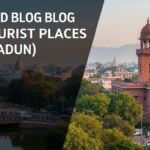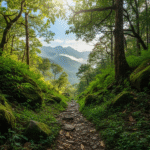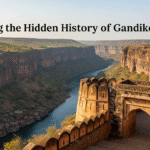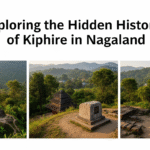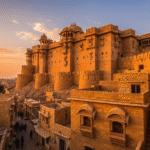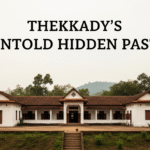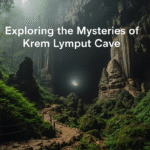Imagine being on a beach where the sands are not just decades old. They are billions of years old. In Singhbhum, Jharkhand, India, scientists have found what might be the world’s first beach. It dates back an amazing 3.2 billion years. Researchers have given evidence that continents may have formed much earlier than we thought. This evidence is from Singhbhum. These findings are not just interesting facts. They make us think more about how old Earth is and how continents formed.
The story we used to believe was that continents formed about 2.5 billion years ago. But, the secrets of Singhbhum suggest a new timeline that adds an extra 700 million years. This doesn’t just change Singhbhum’s place on the map. It also shines a new light on how our planet and landscapes came to be.
Key Takeaways
- The age of Earth’s first continents might have been about 3.2 billion years ago, according to new studies.
- Singhbhum might be where one of the oldest beaches on Earth is located.
- This discovery moves back the timeline of when continents were formed by 700 million years.
- The ancient sandstones and geological features of Singhbhum help us understand Earth’s early days.
- The mysteries around Singhbhum give us important views on climate change and natural history.
The Age-Old Enigma of Singhbhum’s Earliest Beaches
Geologists and historians are eager to solve Singhbhum craton’s secrets. It’s a place with some of Earth’s earliest lands. Studies have found evidence of the world’s first beaches there. This might change what we think about early Earth.
Discovering the World’s First Beach in India’s Heartland
Important discoveries have been made in Singhbhum. Sandstones, over 3 billion years old, show layers. These suggest they come from ancient seas and rivers, pointing to early beaches.
A Geological Puzzle: The Singhbhum Craton
The Singhbhum craton is in Jharkhand’s heart. It’s known for its ancient rocks. These rocks tell us about early Earth’s climate and environment.
Reshaping History: Singhbhum’s 3.2 Billion-Year-Old Sands
Studies of zircon grains in the rocks give us clues. They suggest a huge, ancient beach was here. It helped early ecosystems on land to grow.
| Feature | Description | Age (Billion Years) | Comparative Craton |
|---|---|---|---|
| Singhbhum Craton | Home to some of the earliest beaches | 3.2 | Kaapvaal (South Africa), Pilbara (Australia) |
| Continental Emergence | Earlier than previous estimates by 700 million years | 3.2 | Correlates with findings in similar aged cratons |
| Sandstones | Indicators of ancient tidal plains and beaches | 3.1 | Similar sedimentary patterns observed in corresponding cratons |
This research not only helps us know more about the first beaches. It also makes us rethink when continents formed and how ancient lands shaped Earth.
Mysterious facts about Singhbhum: Unearthing Prehistoric Geology
The landscape of Singhbhum is a beautiful mystery. It has prehistoric Singhbhum geology that makes people wonder. There are mysterious Singhbhum artifacts that are very old. They are known for raising more questions than answers.
Singhbhum is important on India’s geological map. It has lots of minerals and complicated geology. This is because of old volcanoes and earth movements. These things might help us understand magma’s effects more than just looking at the surface.
There’s a theory about the mysterious Singhbhum area. It says that not just tectonic shifts made its first land formations. Molten magma coming up from deep down played a big role too.
This theory could change how we see the Earth’s early days and weather changes over time.
To make sense of unexplained phenomena in Singhbhum, looking at detailed data could help:
| Feature | Description | Implications |
|---|---|---|
| Magma Injections | Irregular basaltic formations in Singhbhum indicating deep magmatic activities. | Supports the hypothesis of sub-surface geological formations. |
| Mineral Deposits | Rare minerals suggesting intense past geochemical processes. | Shows the economic and science importance of old Singhbhum geology. |
| Fossil Records | Different fossil types show changing weather over time. | Shows big weather changes, maybe because of local geology. |
Singhbhum’s mystery keeps attracting scientists. The new ideas it brings could change old stories of Earth’s geology and environment.
Significance of Landmass Formation: Singhbhum’s Role in Plate Tectonics
The discovery of Singhbhum’s ancient landmass has changed how we see the Earth’s early lands and environment. It gives us important clues about landmass formation. These clues help us understand plate tectonics and continental drift from over 3 billion years ago.
By looking at Singhbhum’s rocks, scientists can figure out Earth’s old landscape. These rocks, older than our current ideas of plate tectonics, help. They show what the world was like when the first continents were forming.
Significance of geological history in Singhbhum is seen when compared to ancient areas like the Kaapvaal Craton in South Africa and the Pilbara Craton in Australia. These places are similar in age and sediment types. This suggests that the early Earth might have been connected.
- The landmass in Singhbhum appeared about 3.2 billion years ago. It was among the first continents.
- This ancient landmass was key for later geological events and life’s beginnings. It helped create Earth’s atmosphere and life itself.
- Singhbhum’s rocks tell us a lot about the early air and land shapes. They are very special.
Studying Singhbhum and plate tectonics deepens our knowledge of how continents work. It also helps us learn about landmass formation in the early days of Earth. Singhbhum is a major piece in the big picture of our planet’s geological history.
Singhbhum’s Unexplained Phenomena: Anomalies in Geological Patterns
The Singhbhum region is full of surprises. Its geological oddities go against normal science rules. It’s known for very old sandstone. This spot in Jharkhand, India, helps us know how continents formed at the start. Recent discoveries say Singhbhum was above ground 3.2 billion years ago. That’s 700 million years sooner than we thought.
Studying rocks in Singhbhum tells us about their hot and high-pressure birth. This backs ideas that magma, not just plate movements, formed the land. This is key for new theories. They think Earth’s inner heat and chemistry shaped its early days more than assumed.
Sandstone Signatures: Dating Back Millennia
Singhbhum’s special sandstone is not just a rock. It’s a piece of history from billions of years ago. These rocks are like ones in South Africa and Australia. They show early Earth had similar ground everywhere.
Alternative Theories: Beyond Conventional Understanding
These discoveries make us rethink how continents came to be. It’s not just about land plates moving. Hot magma and other natural forces might have created the first continents. This idea is now more accepted in science.
| Feature | Age (Billion Years) | Significance |
|---|---|---|
| Emergence of Singhbhum Landmass | 3.2 | Major shift in the timeline of continental formation |
| Singhbhum Sandstones | 3.1 | Evidence of ancient beach environments |
| Formation of First Continental Crust | 3.2 | Aligns with the emergence of Singhbhum land |
Looking into Singhbhum’s oddities changes how we see Earth’s story. It also gives us new angles on climate change and life’s history here.
Intriguing stories of Singhbhum: Folklore Meets Science
Singhbhum’s tale is a mix of old stories and science. This old place is known for its forests and minerals. It has tales and science studies. Its past stories are part of its culture and seen in old tales and new findings.
These stories are important to Singhbhum’s history. Folklore and science here are closely linked. The science in Singhbhum is richer because of its folklore.
Legacies Carved in Stone: Ancient Narratives
Singhbhum folklore talks about gods, giants, and how the earth was made. These tales may actually explain geological events. Stories of battles and gods’ works often align with the land’s geography.
Myths Intertwined with Geological Findings
In Singhbhum, myths and archeological finds make an interesting mix. The famous rocks and places in tales often have rare minerals or strange rocks. This shows these myths were based on science too.
Local stories sometimes hint at scientific finds. Tales of treasures and wonders led to exploring. This led to important finds. Singhbhum’s stories and research add to its cultural depth and history.
The Singhbhum story shows how folklore and science can blend well. Its stories connect old with new, myths with facts. They make the past and the mysterious clearer to us.
Singhbhum Secrets: The Cultural Tapestry of an Ancient Land
The region of Singhbhum has a long history. It is famous for its natural resources and colorful culture. The local art, like embroidery and appliqué, links people through time. It celebrates traditions that are very old.

Artisans here use age-old methods to make beautiful textiles. These textiles tell stories of the past. They show personal hopes and community tales.
The textiles are more than just clothes or decorations. They hold the spirit of the ancestors of Singhbhum. They show a love for nature and art. Some techniques use precious metals. They show Singhbhum’s rich past and love for beauty.
The Banjara embroidery uses colors, mirrors, and beads. It shows the lively spirit of Singhbhum’s people. They are creative and love freedom.
There’s a tradition of using old fabric in new art. This is seen in kantha and khatwa work. It combines beauty with reusing materials. Every stitch tells a story of Singhbhum’s long history.
Looking into Singhbhum’s fabric arts gives a glimpse into its soul. This place blends art with nature beautifully. It creates a lasting heritage amid forests and red soil.
Singhbhum Legends and Their Impact on Modern Research
Singhbhum’s folklore and modern research are closely linked. This partnership has made the scientific world richer. It has also made people see the region’s stories in a new light. These tales help unlock Singhbhum’s geological and cultural secrets.
From Craton to Cultural Icon: The Singhbhum Story Retold
The story of Singhbhum has changed a lot. It started as a geological craton and became a cultural icon. The area’s folklore has played a big part in this change. It has given a deeper meaning to research. These stories help scientists see Singhbhum in new ways.
Legendary Insights Aiding Scientific Breakthroughs
Singhbhum’s legends and science have come together. They have led to big discoveries about the land’s geology. The tales let scientists think about how the earth changed here. This mix of legend and research makes science better. It helps find out more detailed information.
| Folklore Influence | Research Impact | Area of Study |
|---|---|---|
| Singhbhum Craton Origin Tales | New Geological Hypotheses | Plate Tectonics |
| Myths of Singhbhum’s Sacred Lands | Cultural Studies Integration | Anthropology |
| Legends of Great Battles and Kings | Ancient Human Activity Insights | Archaeology |
This table shows how Singhbhum’s folklore has been used in research. It has helped us understand the history and science of the area better. Because of this, these stories are still important in Singhbhum’s ongoing story. They keep helping science and exploration today.
Singhbhum Folklore: A Trove of Unconventional Knowledge
The heart of Singhbhum beats with its rich ores and the vibrant Singhbhum myths. These stories show the area’s deep history and culture. They let us see the world through a unique lens of beliefs passed down through time.
Folklore in Singhbhum does more than share old stories; it helps us understand the region’s social and cultural dynamics. Every story, known or not, shares wisdom on living with nature and its laws.

These tales highlight resilience, justice, and respect for earth. They connect to today’s global issues. Diving into Singhbhum’s folklore, we find unconventional knowledge. It challenges known histories and broadens our view of the past.
Folklore links the past to today, key in preserving culture. By exploring these stories, scholars and locals keep the tales alive. They strengthen regional identity and teach others about Singhbhum’s importance.
| Aspect | Details |
|---|---|
| Core Themes | Resilience, justice, environmental reverence |
| Methods of Transmission | Oral histories, local rituals, and cultural festivals |
| Impact on Research | Offers alternative viewpoints and enriches academic discussions |
| Preservation Efforts | Documentation projects, academic studies, community initiatives |
This knowledge isn’t just for academics but also uplifts the local community. It helps them hold onto their heritage while embracing modern life. Singhbhum’s folklore is a living, evolving treasure. It is key for both history and community identity.
Conclusion
The earth of Singhbhum shares an amazing story of change. It shows resolved Singhbhum enigmas that ring through science and history. Learning about Singhbhum’s past is like reading an ancient book. Each chapter shows us new mysteries, pulling us into the wonders of our planet.
Since 1784, the Asiatic Society has sought knowledge non-stop. They search Singhbhum’s lands for clues to our shared history. The Society is dedicated to learning about Asia. They look into Singhbhum’s mix of nature, culture, and stories. This place, with some mysteries solved, shows a story still being written. It tells of the mix and match of people’s work and nature.
This story about Singhbhum isn’t finished yet. New parts of its history keep coming up. They invite more study, promising new discoveries. Thanks to hard work and the Asiatic Society’s spirit, we will keep learning about Singhbhum. Its legends, soil, and struggles keep inspiring us, hinting at more discoveries to come.
Singhbhum Folklore: A Trove of Unconventional Knowledge
What are some mysterious facts about Singhbhum?
Singhbhum might have the world’s oldest beach. This shows it was very important in making the Earth’s continents. It’s full of ancient secrets waiting to be found.
What is the significance of discovering the world’s first beach in Singhbhum?
Finding the first beach in Singhbhum changes how we see Earth’s history. It suggests the first lands appeared 3.2 billion years ago. This changes our view of how land started.
What is the Singhbhum Craton?
The Singhbhum Craton is a very old rock area in Singhbhum. Scientists found rocks there that could be from Earth’s first beaches. They are billions of years old.
How is Singhbhum reshaping history with its 3.2 billion-year-old sands?
The ancient sands of Singhbhum make us rethink how continents came to be. This place puts Singhbhum at the center of a big story about Earth’s first big lands.
What unexplained phenomena in Singhbhum have scientists uncovered?
Scientists saw weird rock shapes and patterns in Singhbhum. These don’t fully match what we thought about old Earth’s rocks.
How does Singhbhum relate to the study of plate tectonics?
Singhbhum’s rocks might change our ideas about plate tectonics. The way its land formed might not just be from plate movements.
What are the sandstone signatures in Singhbhum?
Singhbhum’s sandstone signatures are old marks in sandstones. They show how old the place is and what Earth was like then.
What alternative theories about Singhbhum’s geological history are being considered?
Some think magma from deep Earth also made early continents, not just plates moving. Singhbhum is key in studying this idea.
How do the ancient narratives and legends of Singhbhum complement geological findings?
Old stories from Singhbhum match the geology findings. They tell about the same events and times shown by the rocks.
What cultural heritage does Singhbhum have?
Singhbhum has a deep culture tied to its old geology. This includes stories, folklore, and traditions that show the land’s history.
How have Singhbhum’s legends influenced modern scientific research?
Singhbhum’s legends give clues that help scientists. They offer ideas and guide studies into its very old history.
What role does folklore play in exploring Singhbhum’s mysteries?
Folklore helps solve Singhbhum’s mysteries. It keeps unusual knowledge that fits with what science finds, helping us understand the past.

